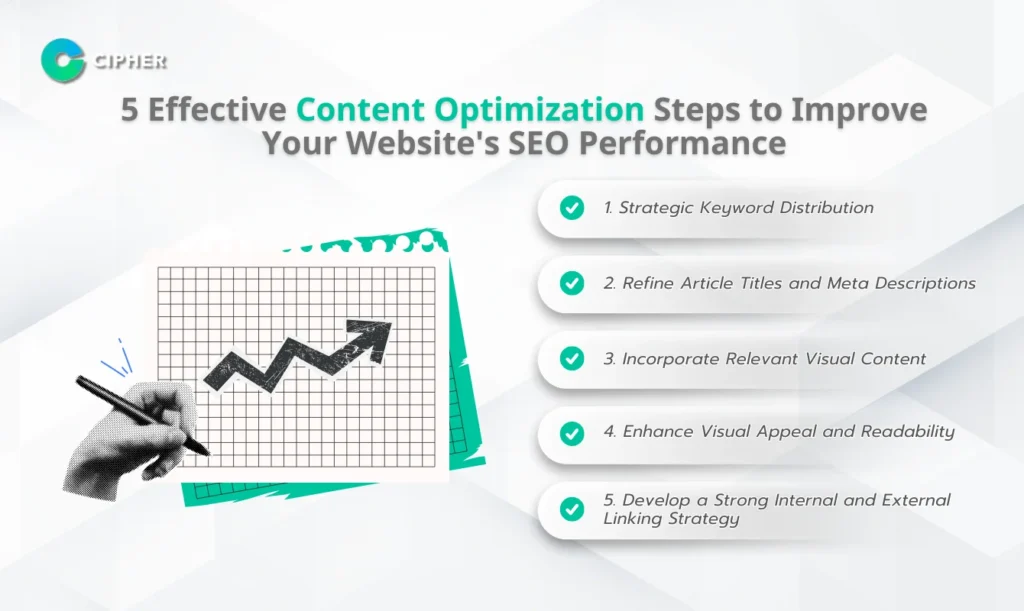Have you ever wondered why some websites rank higher on Google despite having content that isn’t necessarily better than yours? The answer lies in effective content optimization – the strategic process of tailoring your web content to meet both user search intent and Google’s algorithm requirements! Creating successful SEO content begins with understanding the fundamental principles of content optimization.
Table of Contents
Understanding Content Optimization and Its Impact on Search Engine Rankings

Content optimization is the systematic improvement of your website’s content structure and components to satisfy both readers and search engines. The primary goal is to maintain or increase your rankings on Google Search while delivering an exceptional user experience. Well-optimized content significantly increases your website’s chances of achieving higher search engine rankings.
Google constantly updates its algorithm daily, which is why web content that once ranked on the first page might drop to pages 2-3 in subsequent months. Digital marketers must regularly optimize website content to maintain visibility. Implementing social optimization alongside SEO strategies can dramatically enhance your overall digital marketing effectiveness.
Why Content Optimization Is Critical for Your Website's Success
1. More Precise Audience Targeting
After publishing initial content, conversion data reveals who your actual audience is, allowing you to optimise your website content to better match their search queries. Effective content optimization involves leveraging user data to develop SEO articles that genuinely resonate with your readers.
For example, if analytics reveal your primary audience consists of Baby Boomers, you might adjust your product examples to better suit older adults and simplify language across your website content targeting seniors.
2. Faster Ranking Improvements Compared to Creating New Content
SEO articles that have previously ranked on Google typically see faster ranking improvements through strategic updates rather than creating entirely new pages. This occurs because search engine algorithms recognize these pages already have established readership and greater credibility than newly published content. Websites with regular site optimisation earn greater trust from Google.
3. Opportunity to Correct and Enhance Content
When Should You Perform Content Optimization?
Professional SEO teams regularly monitor website rankings and typically consider content optimization when:
- Rankings begin to decline (e.g., moving from page 1 to page 2)
- Competitor websites achieve better search engine rankings
- New industry information becomes available for inclusion
- Search trends or user behaviors evolve
5 Effective Content Optimization Steps to Improve Your Website's SEO Performance

1. Strategic Keyword Distribution
Random keyword stuffing is ineffective since Google prioritizes user experience. To properly optimize website content, strategically distribute keywords in these critical locations:
- Article title (H1 heading)
- Meta description
- First paragraph of the article
- Main subheadings (H2 headings)
- URL structure
2. Refine Article Titles and Meta Descriptions
Ensure your article titles and meta descriptions contain your primary keyword while remaining readable and concise – crucial elements of search engine optimization.
If the phrasing doesn’t feel natural, try restructuring with your main keyword positioned near the beginning, and if space allows, include your brand name to build recognition and strengthen your site optimisation efforts.
3. Incorporate Relevant Visual Content
Embedding relevant videos within your website not only enhances engagement but also increases your chances of achieving better search engine rankings.
If videos aren’t practical, high-quality images (with optimized file sizes) can encourage visitors to spend more time engaging with your page – a key factor in effective content optimization.
4. Enhance Visual Appeal and Readability
Long blocks of uninterrupted text often cause reader fatigue and increase bounce rates. Improve your content optimization by enhancing visual appeal through:
- Strategic image placement between paragraphs
- Quote blocks that emphasize key points
- Clear visual indicators for subheadings
- Section dividers that organize content logically
5. Develop a Strong Internal and External Linking Strategy
Latest Content Optimization Trends to Enhance Your Website's Performance
1. Prioritize User Intent Over Keyword Density
Google’s algorithms increasingly prioritize the searcher’s intent over specific search terms. Create content that genuinely addresses what readers want to know, rather than simply inserting keywords to drive traffic. Understanding user needs forms the cornerstone of successful search engine optimization.
2. Leverage AI and Automated Tools for Content Analysis
3. Optimize for Voice Search Compatibility
4. Expand Video Content Integration
5. Ensure Mobile Responsiveness
Social Content Optimization: The Critical SEO Component You Shouldn't Overlook
Beyond traditional content optimization for search engines, adapting content for social media platforms through social optimization is equally crucial as it drives engagement and sharing of your web content. Integrated marketing that combines both SEO and digital marketing strategies creates powerful synergy, built on three key principles:
1. Ensure Universal Readability and Visibility
2. Create Visually Arresting Content
3. Minimize Distractions
Comprehensive Content Optimization Services to Transform Your Website Performance
In-depth SEO Content Audits & Strategic Planning
Professional Content Enhancement & Refinement
Integrated Social Optimization Strategies
Technical SEO Upgrade
Social Optimization Strategy
Summary
Content optimization resembles updating your SEO content to newer, more effective versions. Rather than a one-time task, it represents an ongoing process requiring regular attention. Begin by analyzing current rankings, identifying opportunities for improvement, and implementing the strategic steps outlined above. Digital marketing specialists can significantly enhance your content optimization effectiveness, helping you achieve sustainable search engine visibility and business growth.





